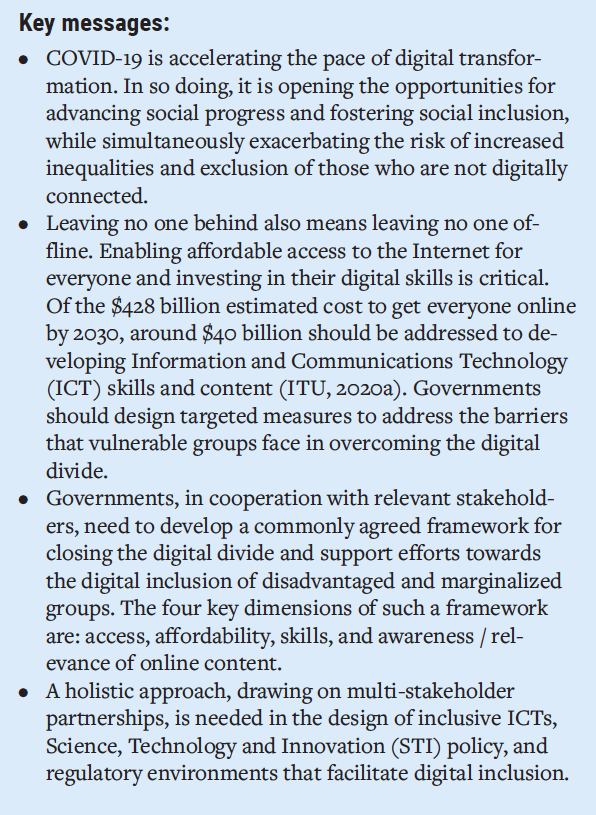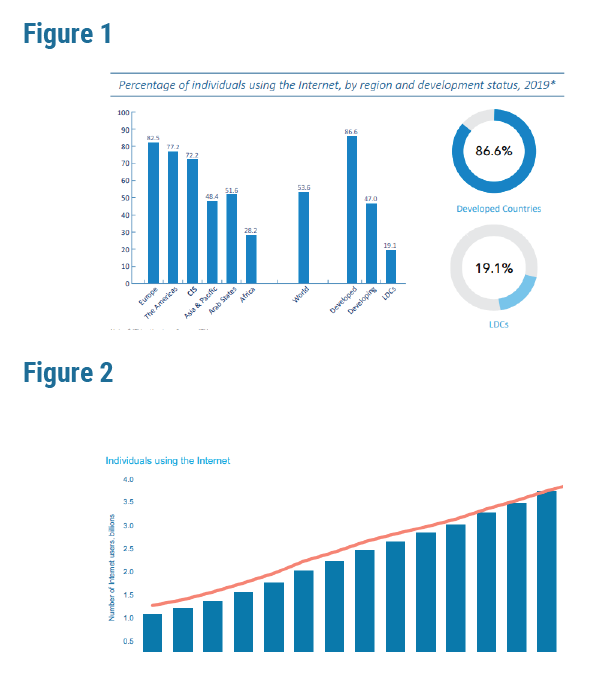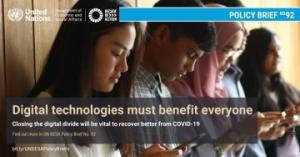 COVID-19 is accelerating the pace of digital transformation: implications for social inclusion
COVID-19 is accelerating the pace of digital transformation: implications for social inclusion
Successive lockdowns and confinement measures put in place by governments to curb the spread of COVID-19 are accelerating the pace of digital transformation as information and communications technology (ICTs) are used to sustain daily lives and support business continuity. Recent forecasts expect the number of employees working remotely globally is set to double in 2021 (Chavez-Dreyfuss, 2020). Internet traffic has surged, as individuals are increasingly moving online to work, communicate, socialise, consume and seek entertainment (OECD, 2020). Companies and industries have also been adapting to the trend, accelerating the digitization of their products portfolio, core internal operations (e.g., back-office, production and R&D processes) and supply-chain interactions by three to four years (McKinsey and Company, 2020). National and local governments are broadening the range of services provided online including business registration, submission of taxes, birth certificates, and forms of identification (UNDESA, 2020b).
Rapid digital transformation already taking place prior to the COVID-19 crisis has accelerated during the pandemic, leading to the expansion of opportunities for digital inclusion. The exponential increase in e-commerce has created new jobs and income earning opportunities, which have the potential to spur household income, lift people out of poverty, and increase resilience of rural communities. In China, e-commerce is helping to revitalize rural villages by widening market access for rural producers. In Chile, the Ministry of Agriculture has set up digital platforms to promote family farming products. In Ghana, a business-to-business e-commerce platform, Agrocenta, connects 10,000 farmers with buyers, allowing farmers to secure a higher price for their production.
Contact restriction measures in response to the crisis have accelerated the digitization of the delivery of essential public services. Over 90 per cent of ministries of education have enacted some form of policy to provide digital and broadcast remote learning (UNICEF, 2020) to address the needs of almost 1.6 billion students (more than 91 per cent of students worldwide) who have been impacted by the COVID-19 crisis (UN, 2020a). For instance, the Fijian Government is supporting learning continuity by delivering curriculum content through radio and the ‘Walesi’ initiative that provides a dedicated education channel on Digital TV, Satellite TV and Mobile application. In many countries, the crisis is also driving the adoption of eHealth, accelerating the uptake and deployment of teleconsultations, electronic health records, and eLearning for the health workforce. In Tanzania, the Ministry of Health has partnered with the e-Government Authority and all mobile network operators through the Tanzania Communication Regulatory Authority to provide free-of-charge information and free calls to health experts through a special short code number 199 dedicated to COVID-19.
Technology has also played a crucial role in enhancing social protection delivery to support the most vulnerable, not only in governments’ immediate response to COVID-19 but also as part of national recovery plans. Governments have used digital means (often in collaboration with the private sector and civil society organizations) to extend social protection coverage and more efficiently disburse financial support. The Luxembourg government has set up an online/phone-based sales platform “Letzshop” offering home delivery of more than 40 basic necessities to vulnerable persons, including persons over 65 years of age and those suffering from chronic diseases or who are immunocompromised. In Viet Nam and the Philippines improvement in database management improved transparency in the beneficiary lists of social protection programmes, by addressing inclusion and exclusion errors. In Togo, the digital social safety net program ‘Novissi’ provides financial support to vulnerable informal workers whose daily revenues have been affected by the COVID-19 crisis. Citizens register on their mobile phones and those eligible receive bi-monthly cash transfers equivalent to 30-35 per cent of the minimum wage, paid directly into their mobile money accounts. The government of Bangladesh, in collaboration with the four largest national Mobile Money Operators, implemented a mobile-powered cash assistance programme for 5 million families impacted by the pandemic in April 2020.
Rapid digitalization in 2020 has also accelerated the shift towards digital finance. Digital Tools (e.g., mobile money and e-wallets, crowdfunding, alternative credit scoring, and cross-border remittances) have the potential to support financial inclusion of underserved persons and communities, reduce costs, and provide new livelihood and market opportunities. Well-known examples of mobile money include Kenya’s M-Pesa and China’s Alipay. Yet, this accelerated pace of digital transformation spurred by the COVID-19 crisis is a double-edged sword for social inclusion efforts. While the crisis has brought new evidence of the benefits of connectivity in protecting people’s health and livelihoods and supporting an inclusive recovery, it is also widening and deepening the digital divide within and between countries, exacerbating inequalities, and further excluding those who are not digitally connected.
Ensuring that every person has safe and affordable access to the Internet will be crucial to realising the full potential of digital technologies in accelerating the implementation of the 2030 Agenda. Given the intrinsic interconnectedness between the digital divide and existing socio-economic inequality, it is imperative to enhance efforts to address the digital divide and promote digital inclusion. The United Nations Secretary-General António Guterres has put forward a comprehensive and holistic vision towards achieving this in his Roadmap for Digital Cooperation, issued in June 2020 (UN, 2020b).
Identifying those left behind by digital transformation and closing the digital divide through digital inclusion
 Leaving no one behind means leaving no one offline, yet, half of the world’s population, an estimated 3.7 billion people, does not use the Internet. While the number of persons online has increased rapidly in recent years, there are important differences between regions and countries (see figures 1 and 2 below). Four-fifths of the offline population are located in Africa and Asia-Pacific (ITU, 2017). In 2019, 87 per cent of individuals in developed countries were online, compared to 47 per cent of people in developing countries, and 19 per cent in the least developed countries (LDCs) (ITU, 2019).
Leaving no one behind means leaving no one offline, yet, half of the world’s population, an estimated 3.7 billion people, does not use the Internet. While the number of persons online has increased rapidly in recent years, there are important differences between regions and countries (see figures 1 and 2 below). Four-fifths of the offline population are located in Africa and Asia-Pacific (ITU, 2017). In 2019, 87 per cent of individuals in developed countries were online, compared to 47 per cent of people in developing countries, and 19 per cent in the least developed countries (LDCs) (ITU, 2019).
Already disadvantaged and marginalized groups are overrepresented in the offline population, which is disproportionately female, rural, poor, comprised of older persons, and/or with limited education and low literacy. Factors such as location, income, age, sex, ethnicity and disability are significant predictors of access to ICTs and the Internet. The persistence of the urban-rural gap, for instance, is evident in the most recent ITU data: globally, the percentage of households with access to the Internet at home in urban areas (72 per cent) is almost twice than in rural areas (38 per cent). This is particularly pronounced in developing countries: in Africa, only 6.3 per cent of households in rural areas has access to the Internet at home, compared to 28 per cent in urban areas (ITU, 2020b). Similarly, older persons are being left behind across all regions. In the United States, 27 per cent of individuals aged 65 years and over do not use the Internet (Anderson et al., 2019). Persons with disabilities face inequalities and additional barriers in accessing the Internet, ICTs and assistive technology, including affordability barriers (due to lower incomes and expenses related to their disability) and the limited accessibility of ICT devices, programmes and websites. Indigenous peoples also face unique challenges in digital inclusion, including the lack of digital content in their native languages.
The digital gender divide is hindering women and girls’ empowerment
Globally, in 2019, only 48 per cent of women used the Internet, compared to 58 per cent of men; this gender gap ranges from 3 per cent in developed countries, to 43 per cent in LDCs (ITU, 2019). Digital technologies and the Internet offer “leapfrog” opportunities and empower women and girls by building their confidence, increasing their economic power and independence, and improving access to knowledge. The digital gender gap is thwarting opportunities and risks, exacerbating inequalities between men and women.
The accelerated pace of digital transformation risks increasing the social exclusion of already vulnerable groups who are not digitally literate or connected
Unequal access to remote learning is a stark example. School closures due to the COVID-19 crisis have exacerbated disparities in learning opportunities. The most vulnerable learners are among those with poor digital skills and with the least access to the hardware and connectivity required for distance learning. According to UNESCO, global estimates suggest that 826 million students are without a household computer, 706 million lack Internet access at home and another 56 million lack coverage by mobile 3G/4G networks (Montoya, 2020). Learners who are not digitally connected are also unable to acquire job-relevant digital skills, further harming their prospects in the labour market.
The COVID-19 crisis has also deepened the digital divide between economic actors. While many high-skilled workers have transitioned to remote working, workers in occupations requiring frequent human contact have not – for example, those providing services such as health care, public transit, food and grocery supplies. The consequences of this imbalance emerged not only in the latter’s higher exposure to health and safety risks during the pandemic but also in the devastating consequences that governmental shutdowns had on their employment rates. Moreover, low access to digital technologies and weak digital capabilities had also significant consequences on micro and small retailers, which have a pivotal role in traditional trade and food outlets. Unable to meet the sudden surge in digital demand, many have faced permanent closures. This resulting loss of small retailers is expected to inhibit the economic recovery in Latin America, South East Asia and Africa, disproportionately affecting the livelihoods of vulnerable populations. Small retailers provide an important source of employment and economic support to millions of poor families, who often rely on them for credit, basic goods and services (Brito, 2020). Similarly, in the field of agriculture, smallholder farmers in rural areas are at risk of being left behind in the digitalization process and failing to reap the benefits of new technologies.
Governments, in cooperation with relevant stakeholders, need to develop a commonly agreed framework for closing the digital divide
As the COVID-19 crisis has spurred the pace of digital transformation, it has simultaneously revitalized the global debate on the digital divide. There is an emerging consensus that the digital divide can only be effectively addressed if it is clearly understood, defined and measured through a commonly agreed framework. Such a framework could inform evidence-based policymaking and allow governments to understand who are the digitally excluded, why they are excluded, and effectively monitor and guide digital inclusion efforts. In recent years, the lens through which the digital divide is understood has widened: shifting from a focus on physical access (ICT infrastructure) and affordability (cost of Internet connection and devices) to a multifaceted understanding of the causes of the digital divide, including cultural and social factors, notably the lack of digital and literacy skills, and the awareness/relevance of the Internet for disadvantaged populations (see box 1 below). These four dimensions of the digital divide need to be tackled together.
With this in mind, there is a clear need for a comprehensive and holistic approach to close the digital divide by promoting digital inclusion, based on a commonly agreed framework as well as specific indicators and metrics, as called for in the UN Secretary General’s Roadmap for Digital Cooperation. To date, global and national digital indexes tend to disproportionately focus on dimensions of access and usage, and rarely cover the dimensions of digital skills and supportive environment. Similarly, most digital indexes are not broken down by age group, gender, and geographical location (Digital Future Society, 2019). As these recommendations are taken forward through a multi-stakeholder process, practical tools (e.g., digital inclusion scorecards) can help provide policymakers and all other actors to identify “pockets” of digital exclusion, where efforts are falling short.
At present national statistical agencies may provide some of the needed data on digital inclusion, but this is dispersed amidst broader statistics, with no singular analysis or focus on these issues. Creating more comprehensive digital inclusion indicators has implications for the collection of disaggregated data, multiplying their complexity and associated costs. An avenue that could be further explored is to make better use of usage data connected to the private sector (such as data collected by the GSMA, which represents mobile operators worldwide) and which provides information not only on access but also digital skills development. The Roadmap for Digital Cooperation also calls on donor countries to consider funding such data collection efforts as part of larger investments in ICT and other infrastructures.
Digital cooperation and partnerships for digital inclusion
Rapid technological change without an inclusive and sustainable development strategic orientation risks entrenching existing inequalities while introducing new ones. Shaping a shared vision on digital cooperation and a digital future must become a priority. This was highlighted by Heads of State and Government in the Declaration on the Commemoration of the 75th Anniversary of the United Nations, adopted on 21 September 2020. Given the unprecedented extent to which our world relies on digital tools for prosperity and connectivity, only a shared vision for a safe, open and free digital world can unlock the full potential of technology and address concerns over digital trust and security.
Strategies to enhance digital cooperation need to be strengthened. The UN Secretary General’s Roadmap for Digital Cooperation envisages eight sets of actions for ‘ensuring digital inclusion for all’ and guides all stakeholders to build a safer and more equitable digital world. These includes ensuring that technology products, polices, and practices comply with human rights principles and standards, notably the right to privacy. Strengthening existing multilateral platforms, such as the UN Internet Governance Forum and UN Commission on Science and Technology for Development and mainstreaming digital inclusion in all UN inter-governmental fora would be important steps towards a more inclusive and equitable society.
Governments and inter-governmental organizations are uniquely placed to support open and transparent public debates on digital issues, in order to develop regulatory frameworks and policies that leverage digital technologies for sustainable development and support digital inclusion. This includes promoting inclusive ICTs design and aligning science, technology and innovation (STI) policy with social development and SDGs.
A whole-of-government and a whole-of-society approach is needed to bridge the digital divide and ensure that ICTs benefit everyone and address the needs of the most vulnerable in society. National and local governments, public institutions, international community, United Nations entities, the private sector, academia, STI or scientific community, civil society organizations, representatives and members of marginalized and disadvantaged groups, and philanthropic and religious organizations, among others, need to work together, each bringing their specific perspectives, expertise and capabilities to the table. By co-designing and co-creating policies with marginalized and vulnerable groups, governments can better identify and address their situation- and context-specific vulnerabilities and needs. Such multi-stakeholder partnerships are also important for fostering innovative and agile solutions to address the complex and evolving needs of vulnerable groups, notably in emergency situations as posed by the COVID-19 pandemic.
To close the digital divide, there is a need to ensure that every person has affordable access to the Internet by 2030. This requires that governments promote universal access to ICT infrastructure, address affordability, enhance digital skills and literacy, and improve the relevance and awareness of the benefits of being online. The digital inclusion of disadvantaged and marginalized groups including, women, older persons, persons with disabilities, people on the move, and indigenous peoples, also requires targeted and multifaceted measures. These include, identifying and amending exclusionary policies and systems, raising awareness of the digital divide, and combating stereotypes through more empowering images of women, older persons, and other marginalized groups in the digital realm. Measures designed specifically to close gender gaps may include establishing gender-responsive national broadband plans, closing the digital skills gap through education, establishing gender-friendly public Internet access and training venues.
As countries emerge from the COVID-19 crisis and seek to lay the foundations for more inclusive, resilient and sustainable economies, closing the digital divide will be essential. While digital inclusion alone is not a ‘silver bullet’ in the fight against poverty and inequality, it has become a fundamental component of promoting social inclusion. As such, digital inclusion is central to Member States’ commitment to leave no one behind in the implementation of the 2030 Agenda and enable a socially just transition towards a more inclusive, equitable, resilient and sustainable future for all.
 Welcome to the United Nations
Welcome to the United Nations
